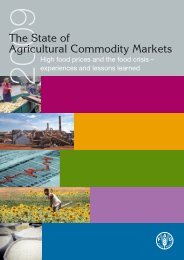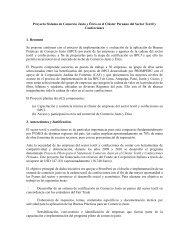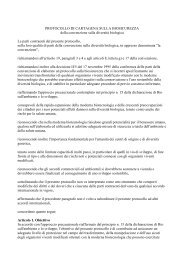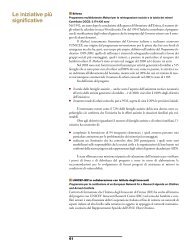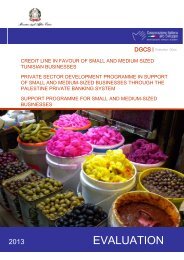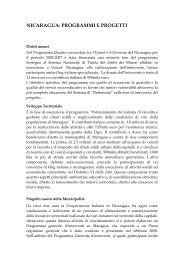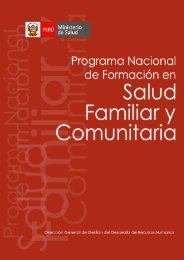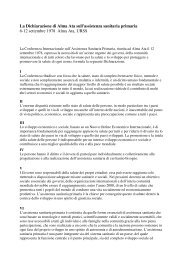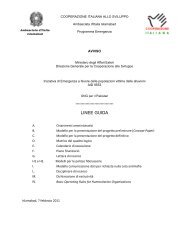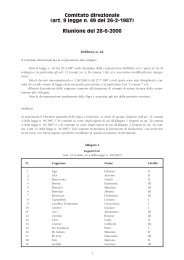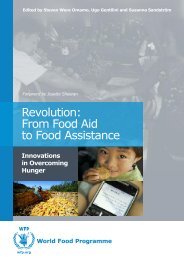FRONTESPIZIO - Cooperazione Italiana allo Sviluppo
FRONTESPIZIO - Cooperazione Italiana allo Sviluppo
FRONTESPIZIO - Cooperazione Italiana allo Sviluppo
You also want an ePaper? Increase the reach of your titles
YUMPU automatically turns print PDFs into web optimized ePapers that Google loves.
68 Carlo Resti, Yohannes Tadesse(including Health Extension Workers) for 73,044,000, there were only 0.53health workers per 1,000 population in Ethiopia at the end of 1997 EC.Figure 1 below also shows availability of human resources for health of variouscategories during the past six years. (excluding the new HEWs cadre).Figure 1 - HRH availability over six years in EthiopiaFigure 1 - HRH availability over six years in EthiopiaNo. per 1000 pop.0.6MD0.50.40.30.20.1MD+ HONursesPharma + tech.HAMD+HO+Nurses+HAHA + NursesAll HW (excluding HEWs)01992 1993 1994 1995 1996 1997Year (EC)Shortages have been more acute in some particular categories of workers that include: surgeons,Shortages obstetricians, have pharmacists been more and midwives. acute in Even some though particular the nurses-to-population categories ratio of has workers become more thatfavorable recently, this is partly due to the inclusion of “junior’ cadres of workers in this categoryinclude: surgeons, obstetricians, pharmacists and midwives. Even though the2 .There is also a critical shortage of midwife nurses, a category that is particularly crucial in view of thenurses-to-population need for addressing the excessively ratio has high become maternal more mortality favorable ratio in the recently, country. Two this of the is partly largestregions (Oromia and SNNP), for instance, had less than one midwife per100,000 people duringdue to the inclusion of “junior’ cadres of workers in this category 2 1997.. There isStaffing for health management and planning tasks has also been equally challenging with thealso decentralization a critical shortage of the health of management midwife system nurses, to thea level category of Woredas. that The is situation particularly of staffing crucialforthe senior positions at the level of the Federal Ministry of Health is also optimal. Currently,considerablein viewproportionsof the needof theseforpositionsaddressingare vacant.theEvenexcessivelythe few positionshighthatmaternalare filled aremortalityeither ratio by in relatively the country. less qualified Two or by of personnel the largest that are regions seconded (Oromia through bilateral and and SNNP), multilateral forstaffedpartner organizations.instance, The majorhad reasons less for than such quantitative one midwife shortages per100,000 may be economic people and fiscal during difficulties 1997. as well asStaffing demandsfor outpacing health supply. management In most casesand production planning could not tasks keep has pacealso with been demands equally due topopulation growth. As shown in the table 1, there has been a significant increase in the number ofchallenging health officers with and nurses the decentralization starting 1994 EC due of to the accelerated health expansion management of training system activities. totheHowever,level oftheWoredas. overall population/personnelThe situationratioofhasstaffingdecreasedforonlythemarginally.seniorInpositionsaddition to theatfactthethat the baseline ratios were excessively high, the rapid population growth and the problems of attritionlevel make of the the efforts Federal of reducing Ministry these ratios of quite Health challenging. is also optimal. Currently, considerableproportions of these positions are vacant. Even the few positions thatThe other reasons for quantitative shortage are the increased shift in demand for modern medical care(from previous reliance mostly in indigenous medical care) as well as due to new and emergingare pathologies. filled are Instaffed addition, either with theby growth relatively of health less technologies, qualified the need or by forpersonnel health human that resources arealso rises as the health sector is highly labor intensive. Training orientations towards more expensiveseconded through bilateral and multilateral partner organizations.and less cost-effective types of health personnel relative to affordability and relative to disease burdenThe also major exacerbate reasons the shortage for of such health quantitative human resources. shortages may be economic and fiscaldifficulties as well as demands outpacing supply. In most cases produc-2 The World Bank. Ethiopia A Country Status Report on Health and Poverty (DraftReport). March 2005. Draft Report No.28963-ET.2 The World Bank. Ethiopia A Country Status Report on Health and Poverty (Draft Report). March 2005. Draft ReportNo.28963-ET.



